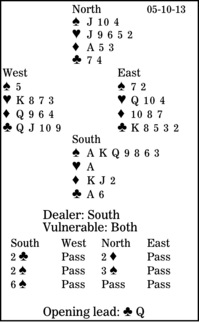Bridge column, May 10: Two chances are better than one

One guesses that plans might have been drawn first. However, a bridge contract will have more chance of success if declarer has two ways to get home and is able to try them both -- as in this deal.
South is in six spades. West leads the club queen: four, eight (encouraging, showing the king), ace. What are declarer's two primary chances to bring home 12 tricks?
South has two potential losers: one diamond and one club. He starts with only 11 top tricks: seven spades, one heart, two diamonds and one club. A 12th winner can be established if either the diamond finesse is working or the hearts are dividing 4-3.
Since the finesse, if it loses, would be instantly fatal (the defenders would cash a club trick), it should be tried second if it is needed.
Declarer must play on hearts immediately. He cashes his heart ace, leads a middle spade to dummy's 10 (happy to see both opponents follow suit), ruffs a heart high, plays a middle spade to dummy's jack, and ruffs another heart high. When the suit breaks 4-3, South leads the spade three to dummy's four, ruffs another heart, plays a diamond to the ace, and discards a diamond or a club on the heart jack.
If hearts break 5-2 or 6-1, South would draw trumps and run trumps, planning to rely on the diamond finesse (but also having a red-suit show-up squeeze if East has the long hearts).
** ** **
COPYRIGHT: 2013, UNITED FEATURE SYNDICATE
DISTRIBUTED BY UNIVERSAL UCLICK FOR UFS

